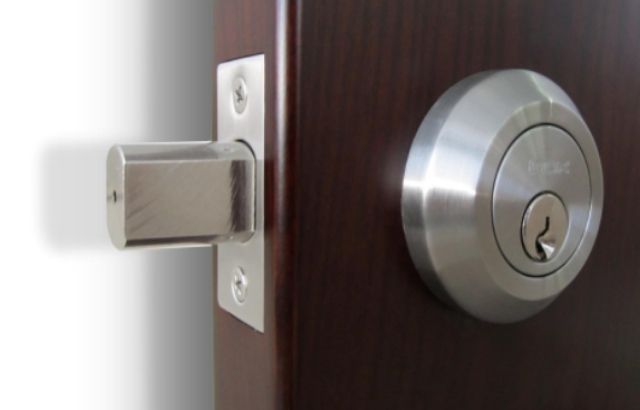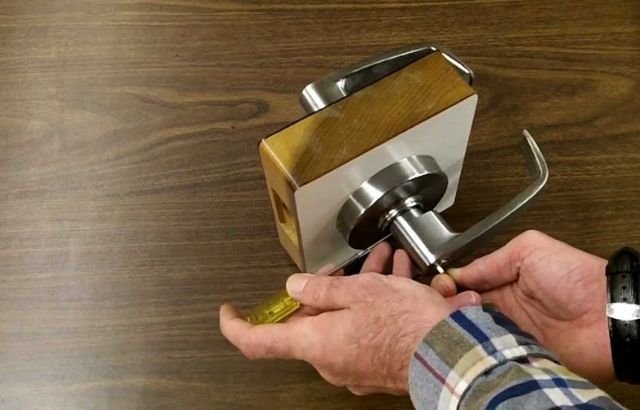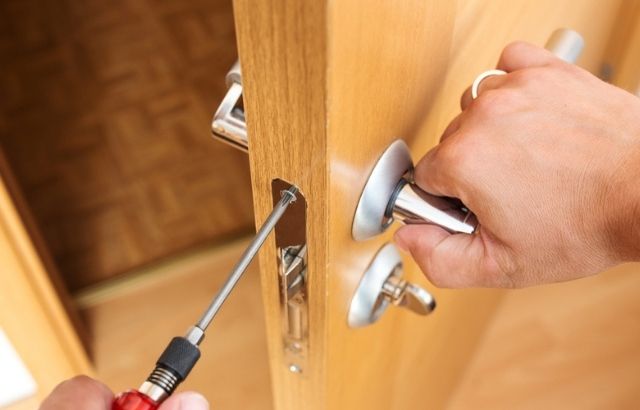I thought to write about removing door locks, especially commercial door locks because most people face a common issue nowadays. I will discuss how to remove the commercial door lock and replace it with the new one. So I will not talk about measuring for new hardware tools, drilling doors, or any other type of non-standard installation. The reason for which I am describing it to you is that the instructions given in the manual are pretty horrible.
How to Remove Commercial Door Lock
If you are planning to remove a residential or commercial lock, you can easily do it yourself. With the appropriate tools and instruments in hand and following the instructions, removing the lock doors is easy.
Read More: Key Stuck In Door Lock
Open the toolbox
Please take out the new lock and all necessary tools from the box and lay them on the table. Before you plan to fix it, notice which end consists of a lock or the hole in the door lock. Keep these pieces of commercial lock-in right to left sequence to be easy for you to take them apart. Most key handles come with the cylinder, and the screw heads are always inside the latch.
Read More: How To Fix A Door Lock
Remove the door handle
Starting from the inside of the door or the side without a key would be beneficial. You’ll see a little hole close to the spot where the handle and door meet, and your latch has a device with a tiny sharp end. To remove a door handle from the main cylinder body, insert this pointed end into the hole and release the spring clip.
Use the tip of a wire coat hanger or a toothpick if the poke tool with your new latch box isn’t long enough to release the catch.
Take hold of the ornamental latch’s decorative cover, a rose, and turn it clockwise for about half an inch. Repeat with the lid of the jam jar. It should start tugging directly in your direction. The inner surface of the support plate is fastened to using a rose insert and two screws. A little piece of engraved metal in the form of a throwing star is attached to the support plate. Two screws are in the plate. To remove them, unscrew them with a long electric screwdriver. You should also put the remaining lock components on the other side of it together after you remove the two screws.
Replace the latch bolt
A latch bolt is a part of a lock that extends to the doorjamb and keeps the door locked and closed. The two screws support this part on the side of the door slab. This may be a tricky task because it can be loose or uncovered or the previous locksmith did a lousy job. The screws have funny-looking, as one end half is like the threaded look and the other head half is like a machine threaded. It would be helpful if you were careful in installing the metal bracket of the lock.
Learn More: How To Install Pocket Door Lock
Install the cylindrical housing into the hole of the door
It is the most significant piece of the cylinder lock, and it has a slot on one side of the housing. And it lines up at the broad side of the latch bolt. Now place the outside support plate and attach it to the cylinder assembly with the help of screws. This plate consists of two prongs; insert these prongs against the door into the two tiny holes.
Fix the outside rose insert on the support plate
It is a heavy, round-shaped piece of metal consisting of two threaded shafts that extend on the inner side of the door.
Install the inside support plate over the lever sleeve
Now you have three hands on the other side of the door. Take two long screws, and fix them on the holes in each of the threaded shafts. Tight the screws carefully, and make sure that every part of the lock should move freely. When you move the cylinder shaft, the latch bolt should also move.
Secure the insert to the support plate
The inside rose insert has two holes in it, lined up with two threaded holes in the inside support plate. Secure the insert support plate with the two small screws.
Sliding the inside lever
Now slide the inside handle or lever over the lever sleeve, and move it few minutes to ensure that nothing is loose.
Install the key cylinder and the outside lever
Installing the key cylinder to the outside lever is the trickiest step because you have to assemble it correctly to get the outer lever over the lever sleeve.
- Fix the outer rose over the rose insert, and you should line up the grooves of the insert with a few indents and twist them clockwise.
- There is a little slotted hole in the center of the housing, and a flat metallic tailpiece will connect to the latch through the cylinder housing; it must be straight.
- The lock cylinder should slip over the lever sleeve, and the tailpiece should decrease over the slot.
- From the outside lever, push the cylinder lock and hold the lever so that you can replace the key into the lock.
- The tip is that when you turn the key, the spring-loaded paper clip will get into place. If you ever want to remove the door lock, youshould turn the access before placing the poke tool into the keyhole.
Types of Residential and Commercial Door Locks
Yes! Door locks are essential tools, as they provide security and safety that no other appliance or instrument can do. They act as a barrier to keep your home and workplace safe and helpful in maintaining privacy. Approximately two million homes broke into each year, thus understanding the significant differences among locks you have. Following are the main types of door locks.

Knob door locks
The most common type of door lock is the Knob lock, as the chief method of getting security. There is a lock cylinder in the knob instead of the door itself.
Read More: How To Fix A Sliding Glass Door Lock
Mortise locks
Mortise locks are the most potent locks and work best on external doors. They are available in both heavy and lightweight duty models.
Passage locks
The passage locks are ideal locks for closets, hallways, and other rooms, as the key is not necessary for it. The safety is operational on both sides of the door.
Channel locks
Channel locks act like pliers and can grip and crush items, like crimping the end of pipes and other metallic objects.
Lock stainless steel grade
Lock stainless steel grade is the natural, light, and real object to take and does not require any particular technique for processing. It can less accumulate water stains and be designed with the hydrophobic property, as it can effectively drain the water away from the surface.
Lock stainless steel grade 3
The locks stainless steel grade 3 is a higher quality of locks than the regular residential locks. They have a lifetime of approximately 250,000 cycles lifetime.
You can use these locks in commercial and residential doors. If you are looking for heavy-duty use, these locks are best.
Lock stainless steel entry door knobs
Lock stainless steel entry door knobs are the door lock used to lock doors and provide security and safety in offices, homes, classrooms, storerooms, job sites, and many more places.
Commercial Door Lock Types
There are six commercial door locks, such as commercial strike keyless entry, restricted critical systems, magnetic locks, and door closers. And master key system. Commercial strike locks are electronic locks used in commercial areas.
How to Remove Commercial Door Lock: FAQs
How do you unlock the commercial door?
You can unlock a commercial door lock with the alternative tool if you don’t have the key. This alternative key can be a tension wrench; insert it into the bottom of the keyhole and apply some pressure. Now insert a pick at the top of the lock; when you apply slight torque to your wrench, scrub the selection back and forth in the keyhole.
Learn More: How To Pick A Door Lock With A Screwdriver
How to open a commercial door lock?
A tension wrench is a crucial tool to open residential and commercial door lock types. This tool holds tension on the pins after they are set with the hook, permitting you to work on the nails you haven’t materialized yet.
How to pick a commercial door lock?
The ideal choices to pick commercial door locks include a small screwdriver or a hex wrench, a paper pin, a heavy-duty paper clip. You can open a commercial door lock with a knife or a fork also.
Conclusion
At first glimpse, the removing commercial door handle and lock procedure seems a little annoying, but if you go through its mechanism and hardware, you will be happy that it is not difficult to achieve. Moreover, you can do the same procedure with the residential door locks also. Hope you have learned how to remove commercial door lock.




